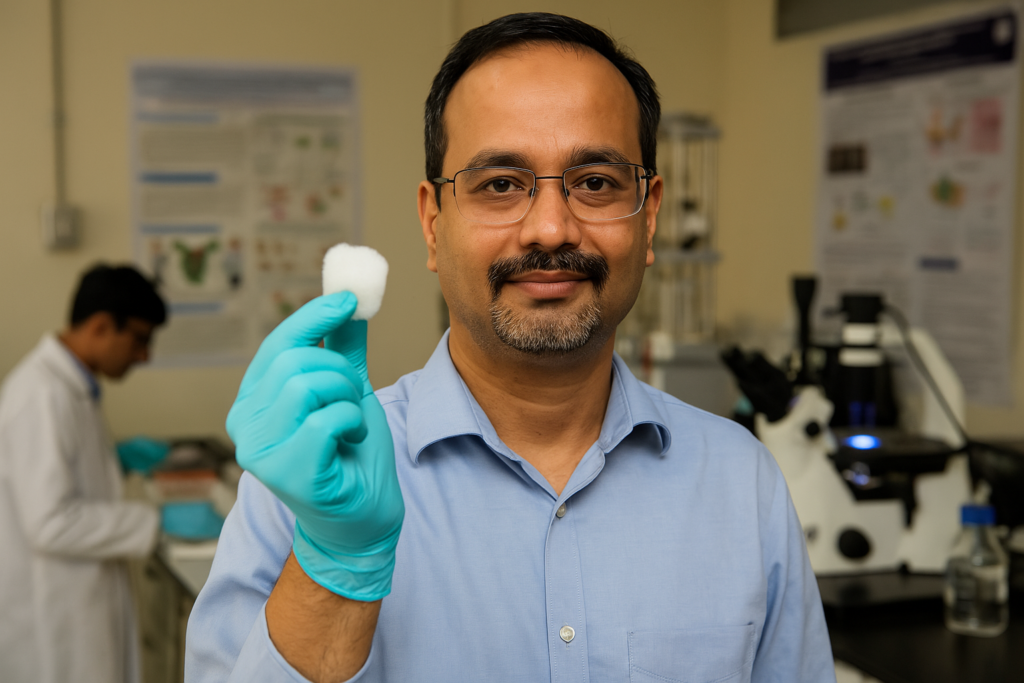A team of scientists at the Indian Institute of Technology (IIT) Kanpur has unveiled a breakthrough in emergency medicine: a biodegradable haemostatic dressing that can stop bleeding in under a minute. The innovation, which has already secured three patents—including one in collaboration with the Defence Research and Development Organisation (DRDO)—could become a life-saving staple in trauma care, military field kits, and emergency medical services worldwide.
At the heart of this advancement is a lightweight cryogel sponge made from agarose, a polymer extracted from red seagrass, and polydopamine (PDA), a synthetic mimic of mussel adhesive proteins. The material not only halts bleeding rapidly but also enhances clotting, reduces inflammation, and supports wound healing—all while being biodegradable and cost-effective.
A Scientific Solution Rooted in Nature
The innovation was led by Professor Vivek Verma, a materials science expert at IIT Kanpur, in collaboration with his student Dr. Kaushal R. Shakya. Their goal was to address a critical need: uncontrolled hemorrhage, one of the leading causes of preventable death in trauma scenarios.
Drawing inspiration from the natural world, the team studied the adhesive properties of marine mussels and the gel-forming characteristics of red algae. These bioinspired materials formed the basis of a sponge that could not only absorb vast amounts of blood but also initiate clotting almost immediately upon contact.
“This haemostatic sponge combines India’s natural resources with cutting-edge materials science,” said Prof. Verma. “It’s not just a bandage—it’s a therapeutic, fast-acting, and affordable tool for saving lives.”
A Leap Forward in Trauma Response
In preclinical trials, the sponge demonstrated clot formation in 30 to 90 seconds, absorbing over 90% of blood almost instantly. Animal model tests showed remarkable success in halting severe bleeding in as little as 40 seconds with minimal blood loss.
Designed for maximum absorbency, the sponge has a swelling capacity of over 4000%, concentrating platelets and promoting coagulation. Its soft, porous structure makes it ideal for rapid deployment in ambulances, operating rooms, and battlefield settings.
Verma notes that the manufacturing process is scalable and inexpensive, opening the door for mass production and widespread distribution, particularly in resource-limited regions.
Why This Matters
Excessive bleeding remains a silent killer across the globe—in road accidents, natural disasters, and armed conflict zones. While commercial haemostatic agents exist, many are costly, difficult to deploy, or lack biocompatibility. IIT Kanpur’s sponge addresses these challenges head-on.
Beyond emergency use, the team envisions applications in rural healthcare, disaster relief, and surgical procedures where immediate bleeding control is critical. Its lightweight design allows it to be packed into military kits, paramedic bags, and remote medical stations, ensuring accessibility in even the most challenging environments.
Looking Ahead
The researchers are currently working with medical professionals to refine the product further, including the development of an injectable version—an innovation that could redefine internal bleeding management. Human clinical trials are expected to begin soon.
This medical innovation from IIT Kanpur exemplifies the power of blending traditional Indian materials with modern engineering. It is a potential game-changer, not only for India but for global trauma care.
“This dressing isn’t just about stopping blood,” said Prof. Verma. “It’s about giving patients a better chance to survive, no matter where they are.”


